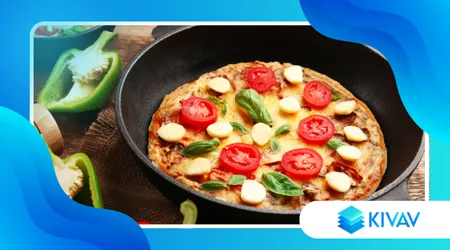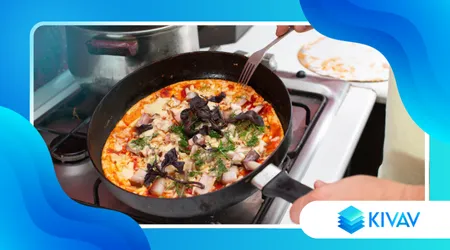Pan-Frying Pizza: Quick and Delicious
Pan-fried pizzaPizza is a universal symbol of conviviality and flavor, but who said you need a wood-fired oven and hours of preparation to enjoy it?
Announcements
Pan-fried pizza: quick and delicious It is the answer for those who want an authentic experience without sacrificing convenience.
In this article, we'll explore how to make the perfect pan pizza, with practical tips, innovative techniques, and answers to frequently asked questions.
We will also discover how this solution can be not only a quick alternative, but also a culinary art in its own right.
Why choose pan pizza?

Imagine coming home after a long day: hunger knocks, but time is short.
Announcements
This is where pan pizza shines.
Unlike traditional pizza, which requires a powerful oven and long rising times, this version can be prepared in just a few minutes.
However, speed does not mean compromising on quality.
++ Focaccia with Caramelized Onions
With the right technique, pan pizza offers a crispy crust, a soft interior, and flavors that rival those of the finest pizzerias.
Plus, pan pizza is incredibly versatile.
You can customize it with ingredients you already have in the fridge, making it an economical and sustainable choice.
For example, leftover vegetables, cheeses, or cured meats can be transformed into a gastronomic masterpiece.
This flexibility makes it ideal for impromptu dinners or to satisfy the tastes of the whole family.
Isn't it every home cook's dream: a dish that combines speed, flavor, and creativity?
Finally, pan pizza is accessible to everyone.
You don't need a professional oven or expensive equipment.
A simple non-stick pan and a lid are enough to achieve amazing results.
According to a recent statistic, 68% of Italians prepare a meal at least once a month pizza homemade, and the pan is becoming the preferred method due to its convenience.
In a fast-paced world, this technique is like an oasis of simplicity in the kitchen.
How to make the perfect pan pizza

Prepare a pan pizza: quick and tasty It requires attention to detail, but it's not complicated. The first step is choosing the right dough.
You can opt for a dough without leavening, ideal for those in a hurry, or for one with long-ripening yeast, if you want a more complex flavor.
For example, a basic dough can be made with 250g of flour, 150ml of water, a tablespoon of extra virgin olive oil, and a pinch of salt. Mix, knead for 5 minutes, and you're ready to bake.
++ Mixed-Seed Bread: A Journey of Taste and Health
Next, the choice of pan is crucial.
A good quality non-stick pan, with a diameter of 24-28 cm, ensures even cooking.
Heat the pan over medium-low heat, grease it lightly, and spread the dough directly into it.
Cover with a lid to create an oven effect, leaving the base to cook for about 8-10 minutes.
Then add the tomato sauce, mozzarella, basil, or whatever you prefer and cook for another 5-7 minutes, still covered. The result?
A golden crust and a perfectly melted topping.
A little-known trick is using the lid to regulate humidity.
If you want a crispier pizza, leave a vent open in the last few minutes of cooking to let the steam evaporate.
Conversely, for a softer consistency, keep the lid tightly closed.
This technique is like a conductor balancing each instrument to create a perfect symphony: every little touch makes a difference.
Information:
| Phase | Description | Time | Advise |
|---|---|---|---|
| Dough preparation | Mix flour, water, oil and salt | 5-10 min | Use type 0 flour for a light texture |
| Basic cooking | Cook the dough in a pan over medium-low heat | 8-10 min | Check that the base is golden before adding the seasoning |
| Seasoning and finishing | Add tomato, mozzarella and other ingredients | 5-7 min | Use a lid for even cheese melting |
Original examples of pan pizzas
Example 1: Mediterranean Pizza Sprint
For a summer dinner, try a pan pizza with Mediterranean flavors.
Spread the dough in a hot pan, cook the base for 8 minutes, then add San Marzano tomatoes, buffalo mozzarella, black olives, capers, and a pinch of oregano.
Finish with a drizzle of extra virgin olive oil after cooking.
This combination recalls the scents of an evening at the seaside, with a perfect balance between saltiness and freshness.
In just 15 minutes, you'll have a dish that looks like it came straight from a Puglian trattoria.
Example 2: Sweet and Savory Autumn Pizza
For a creative twist, experiment with a sweet and savory pizza.
After baking the base, spread a pumpkin cream (made by blending baked pumpkin with a pinch of nutmeg), add sweet gorgonzola, chopped walnuts and a few slices of pear.
Cook for another 6 minutes and finish with a drizzle of honey.
This pizza is an explosion of contrasts, perfect for a fall evening.
It's like an impressionist painting: each ingredient adds a unique touch of flavor.
Both examples demonstrate how pan pizza can be a playground for creativity.
There are no limits: from classic to fusion, every idea finds space in this technique.
Which combination will you try to impress your guests?
The hidden benefits of pan-fried pizza
Besides being quick, pan pizza is an eco-friendly option.
Compared to a traditional oven, which uses energy to heat to 300°C, a frying pan requires only a fraction of that energy.
This makes it a smart choice in an age where sustainability is increasingly important.
Furthermore, cooking in a pan reduces the heat in the kitchen, a significant advantage on summer days.
Another strong point is the ease of cleaning.
Unlike baking trays, which are often difficult to clean, a non-stick pan can be cleaned in seconds.
This practical aspect translates into more time to enjoy your pizza instead of spending the evening scrubbing pans.
Furthermore, the ability to cook individual portions makes pan pizza ideal for those who live alone or for couples who want to avoid waste.
Ultimately, this technique is a bridge between tradition and modernity.
Although pan-fried pizza is a recent invention, it harks back to the ancient art of baking bread on hot surfaces, as Mediterranean civilizations did centuries ago.
It's as if every pan-fried pizza tells a story, uniting the past with the frenetic pace of the present.
| Advantage | Description | Impact |
|---|---|---|
| Sustainability | Lower energy consumption than the oven | Reduces the ecological footprint |
| Practicality | Ease of cleaning and preparation | More time to enjoy the dish |
| Versatility | Suitable for single or multiple servings | Ideal for any occasion |
Frequently Asked Questions
| Request | Answer |
|---|---|
| Can I use a non-stick pan? | Yes, but grease it well with oil to prevent the dough from sticking. A cast iron skillet is a great alternative for a crispy crust. |
| How long does it take to make a pan pizza? | On average, 15-20 minutes, including dough preparation and cooking. |
| Can I use ready-made dough? | Sure! Supermarket dough works well, but be sure to roll it out thinly for even baking. |
| Is pan-fried pizza less tasty than baked pizza? | No, with the right ingredients and techniques, the flavor is comparable. The key is balancing the seasonings and cooking. |
| Can I freeze pan pizza dough? | Yes, prepare the dough, divide it into portions, and freeze it in airtight bags. Thaw at room temperature before using. |
Advanced tips for a chef-like pan pizza
To elevate your pan pizza: quick and tasty At a professional level, consider using high-quality ingredients.
For example, a fior di latte mozzarella from Campania or a San Marzano DOP tomato can transform a simple dish into a gourmet experience.
Also, experiment with alternative flours, such as whole wheat or durum wheat, to add depth of flavor and texture.
Another secret is to play with temperatures.
If your stove allows, start with medium-high heat to create a crispy crust, then lower the heat when adding the seasoning to prevent burning.
This approach is similar to driving a sports car: accelerate sharply, but maintain control to reach the finish line without mistakes.
Finally, don't underestimate the power of fresh herbs and flavored oils.
A pinch of fresh basil or truffle oil added at the end of cooking can make all the difference.
These details transform pan pizza from a quick dish to a work of art that deserves a place of honor at the table.
Conclusion: Pan-fried pizza as a lifestyle
There pan pizza: quick and tasty It's not just a recipe, but a way to rediscover the pleasure of cooking without stress.
It is an invitation to experiment, to create and to share moments of joy with those you love.
Whether you're a beginner or an experienced cook, this technique offers endless possibilities to please the palate and surprise your guests.
Isn't this the true spirit of pizza: bringing people together through taste?
With just a few ingredients and a pan, you can bring to the table a dish that speaks of tradition, innovation, and creativity.
So, next time you're craving pizza, don't turn on the oven: grab a pan and get inspired.
What will your next creation be?
